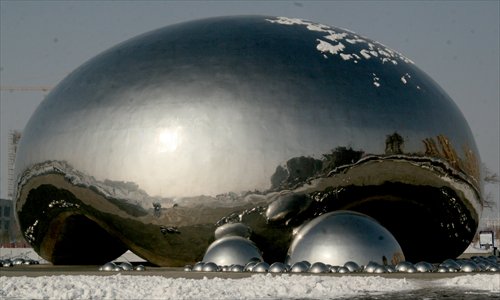
Sculpture known as Big Oil Bubbles in Karamay. (Photo/GT)
Chinese companies have long been known as better mimics than innovators. But now foreigners are increasingly protecting their intellectual property, regularly taking firms to court over what they claim are copies. This trend may force Chinese companies to start taking risks in development rather than taking something that's been proven to work.
In early August last year, several photos of a giant "oil bubble," surrounded by dozens of smaller hemispheres, all made of shiny stainless steel, were widely circulated on the Internet.
The bubbles are part of a new sculpture in Karamay, an oil-boom city in the Gobi desert, Northwest China's Xinjiang Uyghur Autonomous Region. Under the biggest bubble, the centerpiece of the sculpture, lies the disused wellhead of the Karamay No.1 Well, which started to spew oil in October 1955, marking the birth of the Karamay Oil Field, China's first major oil field.
This sculpture was soon slammed as a knockoff by British sculptor Anish Kapoor, who pointed out similarities between the Karamay piece and his famous 2006 Cloud Gate sculpture, also known as The Bean, which stands in Millennium Park, Chicago.
In a statement on August 12, Kapoor said he would sue those responsible for the Karamay sculpture. "The Chinese authorities must act to stop this kind of infringement and allow the full enforcement of copyright," he was quoted as saying by Britain's The Telegraph daily.
"We have a legal team consisting of Chinese and American lawyers," Kapoor recently told the Global Times.
Estonian designer Matti Ounapuu has also found his work has "inspired" a Chinese company. In October last year, he accused tech company Yunzao of plagiarizing his Stigo folding electric scooter.
On October 15, Yunzao, based in Hangzhou, East China's Zhejiang Province debuted two products, including the 4,999 yuan ($765) Yunma X1 folding electric scooter. Ounapuu pointed out that the Yunma X1 resembles the Stigo, and claimed several design features he developed for his scooter have been copied.
When he didn't receive an apology, Ounapuu decided to take legal action. "I'm sad because it was presented as Yunzao's original design where in fact it was not original but based on my design. Copying is one thing but claiming originality of authorship is another," the septuagenarian told the Global Times.
He started a Weibo account with the help of a Chinese friend and expressed his rage over Yunzao's "infringement" in words and video, which received thousands of likes.
On November 17, he posted a stamped legal letter, showing that he and Stigo Co., Ltd, an Estonian tech company, had entrusted Unitalen Law Office, a major Chinese law firm keen on intellectual property rights (IPR) cases, to seek justice.
Wu Shuchen, the partner and a patent attorney at the firm who is in charge of the case, revealed to the Global Times that they are now collecting evidence.
With 16 years of IPR experience, Wu says he thinks that international IPR cases such as Ounapuu's and Kapoor's will likely grow more common and domestic firms will find they have to become more honest.
"As the public awareness of IPR grows and the legal system to protect IPR improves in China, foreign nationals have more confidence in resolving IPR disputes," Wu explained.
'Similar from some angles'
In both cases mentioned above, the Chinese companies have denied plagiarizing their designs.
"We are confident and have adequate evidence to prove our design is not plagiarized," Yang Xu, lead designer of the Karamay "oil bubbles" and teacher at an art college in Chengdu, Southwest China's Sichuan Province, told the Global Times last week in his first public response to the accusations.
"I don't worry about lawsuits. In contrast I am convinced that the judicial proceedings can clear our names," he noted.
According to the 33-year-old sculptor who was born in Xinjiang, his design won the bid from the Karamay government in 2013.
"Before that I had spent a year in the city, researching its unique elements for the design," Yang said. He says that old pictures of oil bubbles from an oil spill, a scene unique to the city, inspired him.
The sculpture was finally completed in October last year. It is made up of a main "bubble," which is 15 meters tall and 28 meters in diameter, and 200 smaller spheres.
Yang admitted that the central bubble looks like The Bean from some angles, but argued that the similarities are hard to avoid when making bulbous sculptures with stainless steel.
"In addition, resembling a turtle shell, mine has four supporting points touching the ground and four doorways leading to the center below the bubble, different from The Bean," Yang said. The Bean has two points touching the ground.


















































